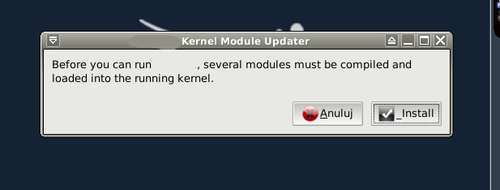Sidux/Useable applications/VMware Player
Appearance
- VMware Player is an application lets you run a virtual machine created by one of VMware products:
- VMware Player is able to make own virtual machines starting from version 3.0
Installation
[edit | edit source]- 1. Download the application from (registration required): http://www.vmware.com/products/player/
- 2. Install it in Terminal as root:
sux ./VMware-Player-version.i386.bundle
- 3. It will run graphic installator script so click on "Install"

- then "Close" after

- The application will be installed in folder: "/usr/lib/vmware"
- 4. Run it from: Menu-> System-> VMware Player - agree with the licence clicking on "Accept"

Running a virtual machine
[edit | edit source]- 1. Now you can test the application - download an image of a virtual machine from:
- 2. Then extract it.
- 3. And load it with VMware Player: Open a Virtual Machine

- I selected Linux Xubuntu 9.04 for example

- 3. Upsss... - my procesor is too old to run a virtual machine.

VMware Player's developer's "Getting Started Guide EN" page 11 says that the minimum for host machine is procesor 1.3GHz and RAM memory 1Gb available on: http://www.vmware.com/support/pubs/player_pubs.html so my laptop exactly has but doesn't want to work. Anyway I'll continiue this chapter working on second laptop with procesor Intel Celeron Dual Core 1.8GHz, RAM memory 3Gb and the same operating system - sidux 2009-04.
- 4. During the first run the player asks for downloading and installing "WMware Tools for Linux" package->
- so click on "Download" - it supports a few extra functions: mouse integration, drag and drop, etc.



- 5. When a guest system starts, install "VMware Tools" package for it too:

- a. Go to "VM" tab-> Install VMware Tools - it will download and mount the package for the guest system.
- b. Open Terminal and make as root:
cd /media/cdrom0 tar xfvz package_name.tar.bz cd vmware-tools-distrib ./vmware-install.pl
- c. Confirm patches for all components and restart VMware Player.


- 5. In a case of any problem you can reconfigure it:
/usr/lib/vmware-config-tools.pl

- 6. System Xubuntu 9.04 has been started with all additional functions of VMware Tools.

Creating own virtual machine
[edit | edit source]- 1. Run VMware Player then-> Create a New Virtual Machine.
- 2. Choose an operating system from:
- a. Device - an optical drive
- b. Or "iso" image file - from local disk
- c. Or I will install later

- 3. I chosen CD drive, then-> Rescan disc-> Next.
- 4. Now choose what kind of operating system you want to install and it's version-> Next.

- 5. Change the machine name and output folder if you want.

- 6. Set maximum virtual disc size as only one file or more.

- 7. If everything is set up click on: "Finish".

- 8. A guest system has been run (MoonOS 2 for example) as a LiveCD, you can install it inside the VMPlayer.

Module re-compilations
[edit | edit source]- It's necessary to re-compile "vmware" module after installation new kernel for host system (sidux).
- But it'll be done itself when you run VMPlayer next time:


Uninstalling
[edit | edit source]- VMware Player is not controlled by the host package manager so you can't uninstall it by "apt-get".
- VMware Player provides uninstalling module to do so.
- 1. You can check what kind of VMware products have been installed:
sux /usr/lib/vmware-installer/1.1/vmware-installer -l
- 2. After a list displacing (I have VMware Player only):
/usr/lib/vmware-installer/1.1/vmware-installer -u vmware-player
- 3. It will run graphical uninstallator-> Next


- and "Close" to finish.

- VMware home page: http://www.vmware.com/
- And on Wikipedia: http://en.wikipedia.org/wiki/VMware
